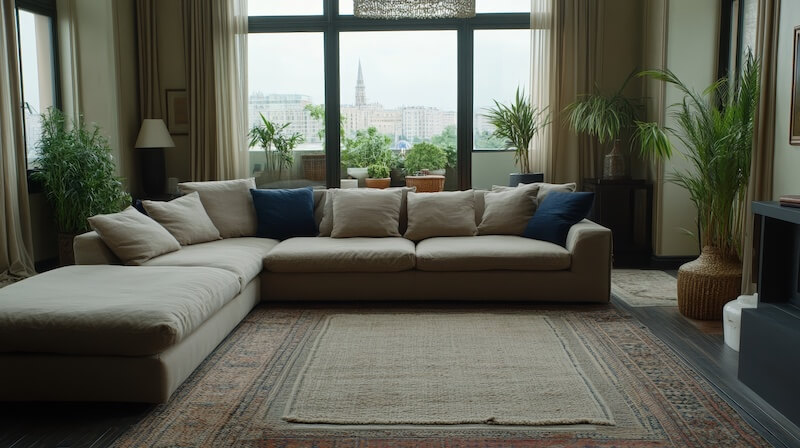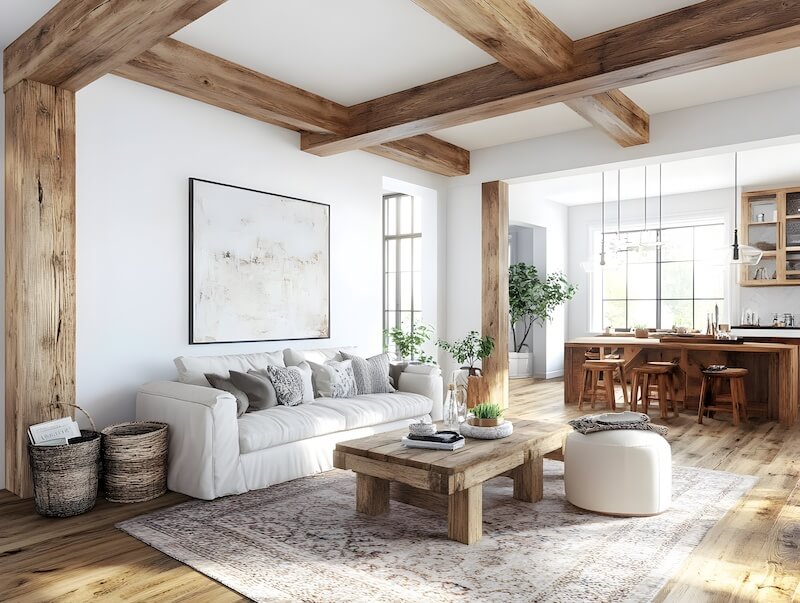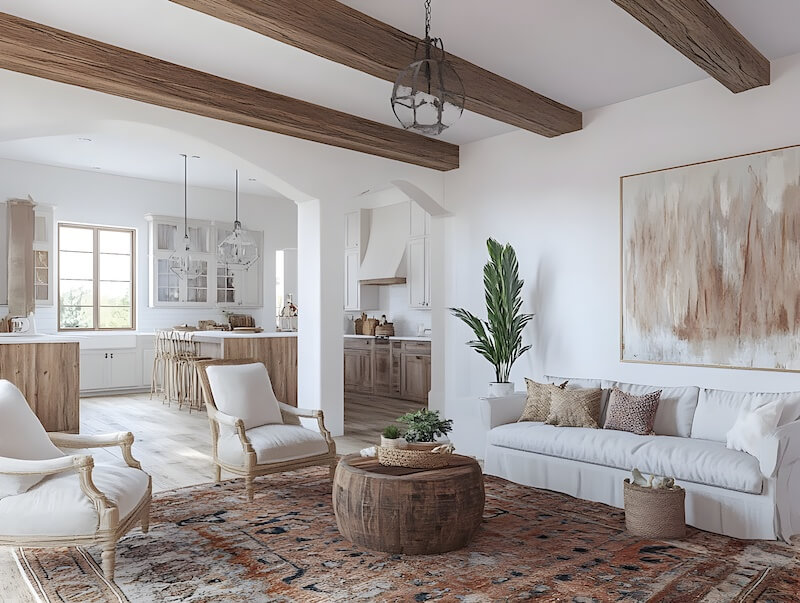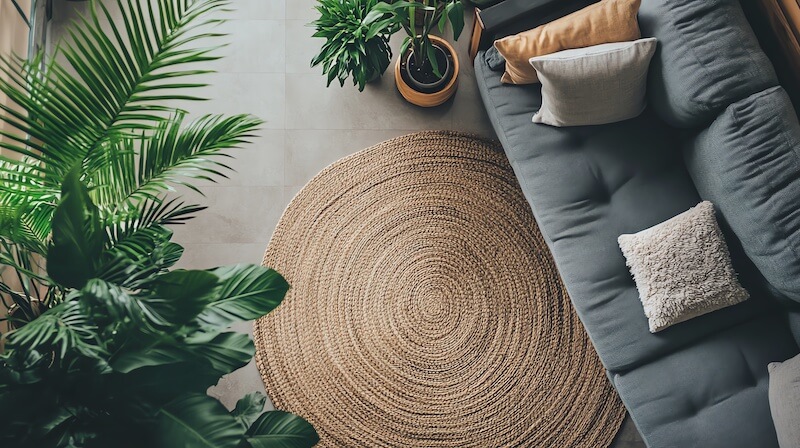When selecting a rug for your living room, you’re not just choosing a piece of decor but defining the space’s ambiance and functionality. The right rug ties together a living room’s furniture, style, and color scheme. Balancing size, material, and design enhances the room’s overall feel. However, many overlook the impact of texture and how it can transform the atmosphere. Let’s explore how the tactile quality of a rug can elevate your living space.
Tips for Choosing a Living Room Rug
- Select a rug size that allows the front legs of all major furniture to rest on it. The rug should be 8×10 or 9×12 feet.
- Choose materials like durable wool or synthetic fibers for easy cleaning, depending on the traffic level.
- Choose a rug color or pattern that complements existing room decor and contrasts with the flooring.
- Position the rug to extend 6–8 inches beyond the sofa on both sides, ensuring it runs its length.
- Avoid common mistakes such as choosing a rug that is too small or a pile height that is unsuitable for the traffic level.
Rug Characteristics
When choosing area rugs, consider size and shape as they define the space and dictate furniture arrangement. Materials and textures vary, from plush wool to durable synthetics, each offering different benefits and maintenance needs. In rooms with wall-to-wall carpet, area rugs can be layered on top to enhance texture and aesthetic appeal.
Selecting the right hue involves matching the rug with your interior design color palette, which can enhance overall aesthetics.
Area Rug Size and Shape
It’s vital to choose the proper size and style of rug for your living room to create a balanced look. Avoid the common mistake of choosing a small rug that doesn’t properly anchor the furniture. When selecting a rug for a living room, ensure it’s large enough for the front legs of all major furniture pieces to rest on. This setup helps visually anchor the space.
The most common rug sizes for living rooms are 8×10 feet and 9×12 feet, as they effectively accommodate most seating configurations and living room sizes. Maintaining a minimum of 30 to 36 inches of clear walkway space between large furniture pieces also ensures comfortable movement around the room. Round rugs can be a great alternative to traditional rectangular ones, especially when paired with round coffee tables.
Similar to making a gallery wall, it’s important to outline the desired rug size and shape using painter’s tape. This will help you visualize the best fit and try different options before committing. Layering a larger rug underneath a smaller one can add depth and texture to your living room.
Rug Materials and Textures

Rug materials and textures influence the style and functionality of living room decor. Vintage rugs can add a unique charm and are often layered over larger base rugs for added texture. A wool rug is ideal for high-traffic areas due to its durability and softness. However, wool rugs typically require professional cleaning.
Synthetic options like nylon and polyester are practical, stain-resistant, and easy to maintain, making them great for homes with kids and pets.
Natural fibers such as jute and sisal have a cool, smooth texture and are easy to clean, though they are not as soft as wool or synthetics.
Cotton rugs are perfect for summer and add a casual, washable element to the space.
The choice of pile height also impacts the rug’s feel and durability—low pile for high traffic and high pile for cozy areas.
Selecting the Perfect Hue
Pick rug colors that align with existing decor to ensure cohesion and prevent clashes.
A patterned area rug can introduce dynamic visual interest, especially in rooms with plain furniture. Lighter hues can open up a space, making it feel larger and airier, while darker tones add a cozy, intimate vibe.
Solid-colored rugs in neutral shades blend effortlessly, especially in eclectic settings or homes with a Scandinavian color palette.
Always choose a rug color contrasting your flooring to define the space distinctly. In areas with heavy foot traffic, patterns and darker colors like black and blue are ideal as they hide dirt and spills more effectively.
Placing Furniture Legs on the Rug

When arranging your living room, ensure that at least the front legs of all seating pieces, such as sofas and chairs, rest on the rug to create cohesive seating areas. This placement ties the room together and avoids a disjointed appearance.
Position the rug to run the length of the sofa. This will further define the seating area and improve the room’s overall layout. Additionally, the rug should extend six to eight inches beyond the sofa on both sides, enhancing the space’s welcoming vibe and ensuring it looks proportionate.
As mentioned before, maintain 30 to 36 inches of clearance for walkways between large furniture pieces, facilitating easy movement and preventing a crowded feel.
Creating a Focal Point with a Vintage Rug

By selecting a large area rug that stretches beyond the edges of the sofa, you can anchor your living room’s decor and establish a harmonious focal point. Vintage rugs can be layered with other types for aesthetic appeal and durability. This choice unifies the space and sets a proportional balance, making the room feel more inviting.
Opting for a patterned or bold-colored rug draws the eye, creating a striking contrast with neutral furniture and walls. This is an excellent way to achieve an accented neutral color scheme.
Using Multiple Rugs in a Single Room
Using multiple rugs in a single room can effectively define different areas, add texture and depth, and create a visually interesting space. This technique is beneficial in large living rooms or open-concept spaces where a single rug may not be enough to anchor the furniture.
Defining Different Areas with Multiple Rugs
Define different areas or zones when using multiple rugs in a single room. For example, you can use a large rug to anchor the seating area and a smaller rug to define the dining area. This technique helps create a sense of separation and functionality within the room.
To define different areas with multiple rugs, consider the following tips:
- Use rugs with different colors, patterns, or textures to create visual contrast between areas.
- Place rugs in a way that creates a clear path or flow between areas.
- Use rugs to anchor furniture and create a sense of stability in each area.
- Consider layering rugs on top of each other to add depth and texture to the space.
Adding Visual Interest with Unconventional Rug Shapes

Unconventional rug shapes, such as round, oval, or octagonal rugs, can add visual interest and create a unique look in a living room. These shapes can accentuate a particular feature, such as a round coffee table, a statement piece of furniture, or abstract wall art.
Using a Sculptural or Amorphous Rug
A sculptural or amorphous rug can be a great way to add visual interest and create a unique look in a living room. These rugs, often irregularly shaped, add whimsy and personality to a space. They can also help you find wall art inspiration.
To use a sculptural or amorphous rug effectively, consider the following tips:
- Choose a rug that complements the shape and style of the furniture and decor in the room.
- Use the rug to create a focal point or anchor a particular area of the room.
- Consider layering the rug over a larger, more traditional rug to add depth and texture to the space.
- Don’t be afraid to experiment and have fun with the placement and arrangement of the rug.
Common Mistakes to Avoid
It’s easy to make mistakes when choosing a rug for your living room, disrupting the space’s functionality and aesthetic. Round rugs are often overlooked but can effectively complement round or oval coffee tables. Selecting a rug that’s too small can fragment the look, so ensure that at least the front legs of all seating rest on the rug.
Many overlook the need for adequate walkway space, ideally 30 to 36 inches, for maintaining a smooth flow. Choosing the wrong pile height can hinder furniture placement; low-pile rugs suit high-traffic areas best.
Additionally, a rug that clashes with existing decor can overwhelm the room. For example, a traditional rug design might seem out of place if your living room is full of modern wall decor. It’s also important to consider maintenance needs; high-traffic areas require durable, easy-to-clean rugs to preserve appearance and longevity.
Choose the Right Rug for Your Living Room
Selecting the perfect living room rug involves careful consideration of size, material, and color to enhance your space. Ensure the rug is large enough for the furniture layout, choose a durable or easy-to-maintain fabric, and pick a color that complements your decor. By placing it thoughtfully, you’ll create a focal point that ties the room together and makes it more inviting. Avoid common pitfalls, and you’ll find a rug that suits your style and functional needs.




